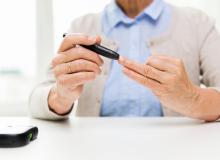Postprandial blood sugar is closely related to complications
The increase in blood sugar after a meal is the main cause of the increase in glycated hemoglobin. The closer the glycosylated hemoglobin is to the normal value, the greater the contribution of postprandial blood sugar.
・ Glycated hemoglobin is less than 7.3%, and postprandial blood sugar contributes 70%;
・When glycated hemoglobin is 7.3%-9.2%, postprandial blood sugar contributes 50%;
・When glycated hemoglobin is greater than 9.3%, postprandial blood sugar contributes 40%.
Glycated hemoglobin is closely related to the occurrence of diabetic complications. Research has found that through hypoglycemic treatment, for every 1% decrease in glycated hemoglobin:
・Microvascular disease decreased by 37%;
・ Stroke dropped by 12%;
・Myocardial infarction decreased by 14%;
・ Diabetes-related mortality dropped by 21%;
・The total mortality rate decreased by 14%;
・All complications decreased by 21%.
It can be seen that controlling postprandial blood sugar and reducing glycated hemoglobin are crucial to preventing diabetic complications.
Postprandial blood sugar control goals
・For patients whose goal is glycated hemoglobin less than 7.0%, the corresponding postprandial blood sugar is less than 10.0mmol/L;
・For newly diagnosed patients with type 2 diabetes, with a short disease duration, younger age, and without diabetic complications or serious concomitant diseases, the corresponding target for glycated hemoglobin is ≤6.5%, and the target for postprandial blood glucose control is ≤7.8mmol/L .
Two misunderstandings about postprandial blood sugar: 1. Fasting blood sugar is good, but postprandial blood sugar may not be good.
Correct a misconception of most diabetic patients: if fasting blood sugar is well controlled, postprandial blood sugar must reach the standard.
In fact, the condition of the remaining pancreatic islet B cells in each type 2 diabetic patient is different, and the drugs used, eating habits and activity intensity are different. Even the same patient will have different dietary changes due to changes in drug taking, diet and exercise. Changes in blood sugar levels are also variable.
Although there is a certain relationship between postprandial blood sugar and fasting blood sugar, postprandial blood sugar is also affected by many factors. Therefore, as a diabetic patient, only fasting blood sugar is measured. If fasting blood sugar is controlled, it is natural to assume that postprandial blood sugar has also reached the standard. This It's very dangerous.
Therefore, while testing fasting blood sugar, people with diabetes should also pay attention to testing postprandial blood sugar.
2 only measure blood sugar after a meal
If the blood sugar control of one meal is up to standard, it does not mean that the post-meal blood sugar of other meals is also up to standard. Therefore, testing post-meal blood sugar means that the blood sugar after three meals needs to be tested and all need to meet the standard.
How to effectively control postprandial blood sugar
1How to eat to lower post-meal blood sugar
Postprandial blood sugar is related to the amount of food eaten and the type of food eaten. The more food consumed, the higher the blood sugar after a meal.
Therefore, when energy intake allows, in order to reduce postprandial blood sugar, the amount of food eaten should be appropriately reduced; if the total intake remains unchanged, postprandial blood sugar can also be reduced by adjusting the type of food. For example, blood sugar should be selected Foods with low production index.
Foods with a low glycemic index have the following characteristics:
・First of all, the lower the carbohydrate content and the higher the fiber content of foods, the lower the glycemic index, so whole grain foods and vegetables are classified as healthy foods;
・The easier to digest food, the higher the glycemic index. Therefore, diabetic patients should drink less porridge to prevent blood sugar from rising after meals.
・Since acidic foods have a low glycemic index, if the taste permits, vinegar or lemon juice can be added appropriately for seasoning, and the glycemic index of the food can also be appropriately lowered.
2How to exercise to lower post-meal blood sugar
One hour after a meal, you can choose an exercise method that suits you, such as walking, doing Tai Chi, swimming, dancing, etc. for 20-30 minutes. You can also adjust the method or time of exercise according to your blood sugar and your actual situation, so as to achieve your goal. After meals, blood sugar is controlled at a satisfactory level.
3Choose medications to control postprandial blood sugar
Currently, medications to control postprandial blood sugar include:
・α-Glycosidase inhibitors (acarbose, voglibose, miglitol) can reduce postprandial blood sugar by 1.4-6.1mmol/L;
・Short-acting sulfonylurea secretagogues (glipizide, gliqidone) can reduce postprandial blood sugar by 2.1-7.8mmol/L;
・ Meglitinide secretagogues (repaglinide, nateglinide, mitiglinide) can reduce postprandial blood sugar by 2.6-6.4mmol/L;
・DPP-4 inhibitors (sitagliptin, saxagliptin, vildagliptin, linagliptin, alogliptin) can reduce postprandial blood sugar by 1.32-4.5mmol/L;
・Short-acting GLP-1 receptor agonist (exenatide) can reduce postprandial blood sugar by 1.01-6.9mmol/L;
・Insulins (short-acting, rapid-acting and premixed insulin).
Diabetic patients choose appropriate drugs according to their condition, and adjust the drug dosage according to their blood sugar control level until their blood sugar reaches the target.
For those with diabetes, in order to maintain good health and meet blood sugar standards, not only fasting blood glucose but also postprandial blood sugar should be tested, and both should meet the standards. Only then can the purpose of reducing complications be achieved, and the standards can be truly met.

